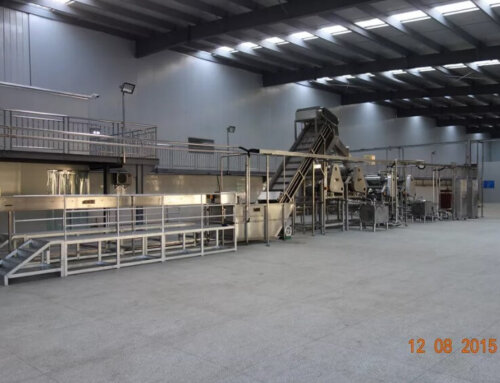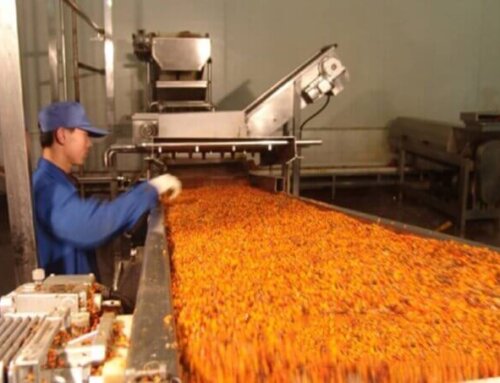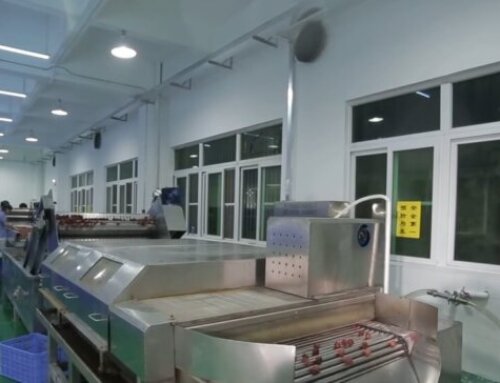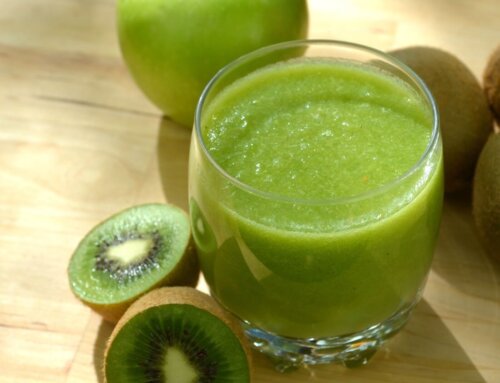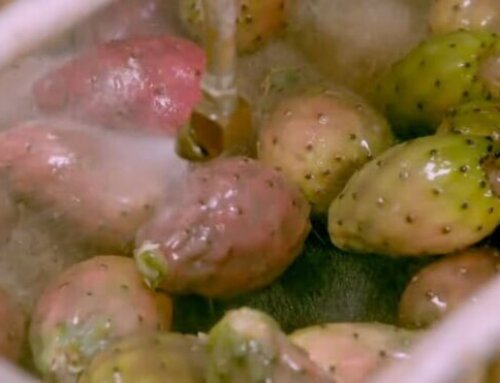Project Description
Grape Processing Line
Grape Processing Line Description
1. Compared with fresh grapes, the juice extracted from fresh grapes has better digestion and absorption. It also contains nutrients such as vitamins, minerals, dietary fiber, and amino acids. It is good for the body after consumption such as relieve fatigue, nourish blood, prevent thrombosis, beautify the skin. Grape juice is often used to make wine, brandy or whiskey after fermentation. In the wine industry, grape juice is an essential product. Most of the grapes in the world are processed into wine, and a small part is processed into grape juice or raisins.
2. Grape juice processing plant includes fresh grape washing machine, grape sorting machine, grape destemmer and crusher machine, grape juice extracting machine, grape juice enzyme treatment tanks, grape juice separating machine, grape juice evaporating and sterilizing machine, grape juice filling machine, CIP system.
3. The whole grape juice processing machine is made of SUS304 material and equipped with CIP system to ensure the sanitary of the grape juice during processing.
4. The fresh grape can proceed into concentrated grape juice, NFC grape juice and red wine through fermentation according to clients different requirements. During processing, the machine has the feature of highly effective and synchronous, fully automatic, flexible, modular and customized.
5. The capacity of the grape processing equipment is from 1000kg per hour to 30000kg per hour. The end products can be filled into bottles, metal cans, carton boxes, pouches or bulk containers.
6. According to the characteristics of easy oxidative discoloration and heat sensitivity of grapes, our equipment adopts a fully enclosed and cold pressing method to obtain grape juice during the juice extraction process to ensure the optimum products.
Grape Processing Line End Products and Package
Concentrated grape juice: The concentrated grape juice Brix value is 65-68, the end grape juice concentrate can be filled into bulk bags in drums, or jerry can bottle, and it is widely used for making RTD grape juice, sweet, wine as raw materials.
NFC grape juice: The NFC grape juice Brix value is 5-12, it uses fresh grapes as raw material. Fresh grape juice is obtained by mechanical pressing, then filtered, blended, sterilized and filled into small bottles, cans or cartons for direct consumption.
Red wine: The fresh grape after extracting or concentrating grape juice through filtration, then fermentation to obtain the wine and filled into the glass bottles.
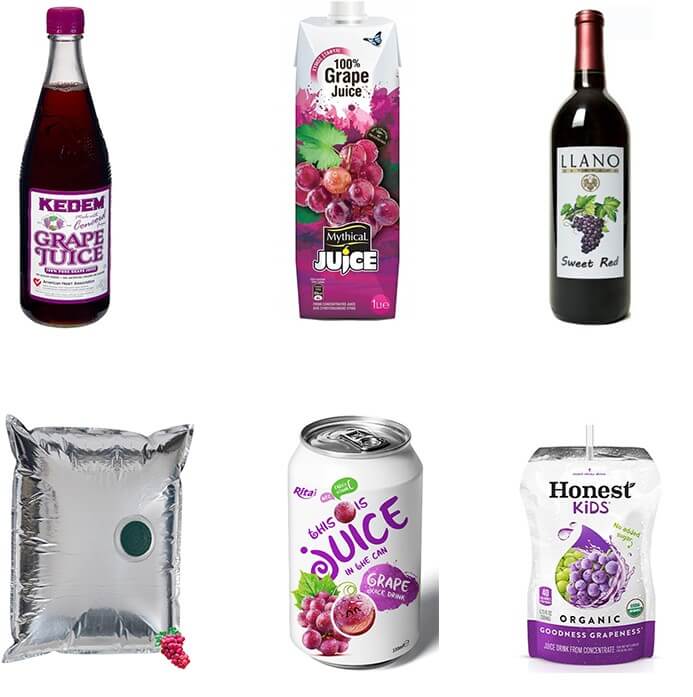
Grape Juice Processing Line Technological Flowchart
Fresh grape after harvesting, then use the drum washing machine to wash off the dust and leaves, then the grapes will be sent to sorting table for picking up the unqualified grapes, after that, the grape will be lifted to the grape destemming crusher to remove the grape stem and ground the grapes into mashes. To obtain a high yield, before the grape mash is sent to extractors, one tubular preheater is applied to inactivate the enzymes in grapes. For juice extracting, the vacuum membrane press or hydraulic press is the most popular method. After juice extracting, the grape juice will be pumped into enzyme treatment tanks, decanter centrifuge separator and disk centrifuge separator for juice clarifying and filtration, then we will get the high-quality clear grape juice. The grape juice can be evaporated, sterilized to make the concentrated juice, or can blended with ingredients, after pasteurized, then filled into a small consumable containers to make the NFC grape juice.

Grape Processing Line Key Machine Introduction
Grape washing and sorting machine
Soak the fruit in 0.03% potassium permanganate solution for 3 minutes, then rinse in running water. This step is to wash away the pesticide residues and dirt or insect eggs on the grape raw materials. We use a high-pressure spray cleaning machine, which consists of a mesh belt conveyor, a spray device,
water collection tank, and the material is conveyed into the spray area through a mesh belt, and is washed up and down under high pressure. Energy-saving and water-saving, and the flushing water is filtered and recycled for use.
The selected equipment is a stainless steel roller-type fruit inspection machine, which is suitable for round fruits and vegetables. The machine consists of a frame, a closed conveyor chain with rollers installed in the middle, a drive reduction motor, a chain transmission device, a bearing device, a main drive shaft, a slave drive shaft, a chain track, a roller track, etc. The main material of the equipment is made of stainless steel, the roller is stainless steel mirror tube, and the track is made of food-specific plastic and rubber, all of which comply with food hygiene standards.


grape destemming crusher machine
Grape destemming crushing machine is separating stem from grapes and ground the grape into mashes. The 304 stainless steel material is hygienic and up to standard, the grape bunches are fed quantitatively, and the grape stem removal rate is higher than 99%. The aperture of the rotating sieve can be customized according to the size of the grape particles to be processed. The gap between the crushing rollers can be adjusted.

Grape juice enzyme treatment process
After the grapes are destemmed and broken for half an hour, pectinase is added to the broken grape mash.
The enzymes that need to be added are pectinase; the purpose is to improve the juice yield and clarity. The addition ratio is: taking the enzyme activity of pectinase 10000u/g, add 5 grams per hundred kilograms of grapes. If the enzyme activity is 20000u/g, the additive dosage will be halved.
The cellulase activity is 20000u/g, and the addition amount is 10 grams per 100 kilograms. The purpose is to destroy the cell wall and increase the juice yield of grapes.
The crushed grape mash is poured into the storage tank through the action of a pump, and the melted pectinase and cellulase are added through the top opening of the enzyme tank. The pectinase and cellulase need water at about 45-65°C. If the temperature is too high, the enzyme will be inactivated. If the temperature is too low, the enzyme will not be able to exert its maximum effect. The time of enzyme action is 1-2h. If the time is too long, the grape mash will be fermented. If the time is too short, the juice yield will be reduced. Generally, the skin residue accounts for 15%. After adding pectinase and cellulase, it needs to be circulated. Enzyme and grape mash are thoroughly mixed.

Grape juice extractor
For industrial grape juice processing, the vacuum membrane press is used to obtain the juice from grape mashes. And sometime for small scale grape juice processing plant, the hydraulic press or screw press is also used. The seedless grape juice yield rate can reach to 90% with this method and process.
The cylinder of the press is divided into two parts: an air chamber and a press chamber. The air chamber is sealed, and the squeezing chamber is equipped with sieve holes along the tank wall. After the squeezing chamber is filled with grape mashes, the air chamber is filled with air. The volume of the air chamber gradually increases and the volume of the squeezing chamber gradually decreases, so that the grape mash is squeezed. The juice is squeezed out from the sieve of the tank and falls into the lower juice collecting tank. After the juice collecting tank reaches a certain position, the juice collecting pump works. After the pressing is finished, the skin residue can be discharged from the manhole.

Grape juice clarification and filtration system
Centrifugal separation makes it easy to process the incoming grapes and limits the number of steps needed to prepare the juice for fermentation or evaporation. You can eliminate draining, pressing cycles and clarification, paving the way to a more efficient, continuous production flow – and saving on labor costs as well as doing away with space-hogging holding tanks. If you use mechanical harvesting, the de-stemming step can also be eliminated. The decanter solutions are ideal for white, rose and red wines when fermentation is carried out in the liquid phase. They are easy to clean, which in turn makes it easy to process different kinds of juice during the same day. They also operate effectively at both low and high temperatures.

Grape juice evaporator
Grape juice is concentrated to 55- 65 Brix. Evaporation has been the most important concentration process for grape juice processing. Evaporators generally include a heat transfer surface, a feed distribution device, a liquid–vapor separator, and a condenser. With grape juice, it is desirable to heat the juice for as short a time as possible and to rapidly cool the product. This minimizes the effect on flavor, aroma, and sugar components. The falling film evaporator systems are used by juice processors and are often coupled with essence recovery systems. The recovery systems are often activated carbon columns that adsorb flavor and aroma compounds.

Grape juice sterilizer and filler
The clarified concentrated grape juice is heated to 93-95°C in a tube sterilizer or a plate sterilizer, maintained for 30S, and cooled to the filling temperature for filling.
The concentrated grape juice filling equipment uses a double-head aseptic filling machine, which is widely used in the aseptic packaging of juice, fruit puree, jam, concentrated juice and other fluids. Under normal temperature conditions, the product can be stored for more than one year. Use a sanitary stainless steel beverage pump to transfer grape juice into a double-head aseptic filling machine for filling.
The NFC grape juice will be filled into bottles, cans, small cartons or pouches, the filling temperature is 85℃ hot filling.


